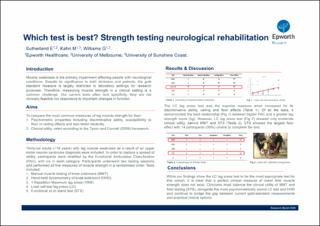| dc.contributor.author | Sutherland, Edwina | |
| dc.contributor.author | Kahn, Michelle | |
| dc.contributor.author | Williams, Gavin | |
| dc.date.accessioned | 2021-02-05T11:16:59Z | |
| dc.date.available | 2021-02-05T11:16:59Z | |
| dc.date.issued | 2020 | |
| dc.identifier.citation | Sutherland, E., Kahn, M., Williams, G. (2020). Which test is best? Strength testing neurological rehabilitation. Epworth HealthCare Research Month 2020, Epworth Research Institute, Victoria, Australia. Hentet fra http://hdl.handle.net/11434/1889 | en_US |
| dc.identifier.uri | https://hdl.handle.net/11250/2726404 | |
| dc.description.abstract | Muscle weakness is the primary impairment affecting people with neurological conditions. Despite its significance to both clinicians and patients, the gold standard measure is largely restricted to laboratory settings for research purposes. Therefore, measuring muscle strength in a clinical setting is a common challenge. Our current tests often lack specificity, they are not clinically feasible nor responsive to important changes in function. While our findings show the LC leg press test to be the most appropriate test for this cohort, it is clear that a perfect clinical measure of lower limb muscle strength does not exist. Clinicians must balance the clinical utility of MMT and field testing (STS), alongside the more psychometrically sound LC test and HHD and continue to bridge the gap between current gold-standard measurements and practical clinical options. | en_US |
| dc.publisher | Epworth Research Institute | en_US |
| dc.subject | strength testing | en_US |
| dc.subject | neurological rehabilitation | en_US |
| dc.subject | muscle weakness | en_US |
| dc.subject | nevrologiske lidelser | en_US |
| dc.title | Which test is best? Strength testing neurological rehabilitation | en_US |
| dc.type | Others | en_US |
| dc.source.journal | Epworth HealthCare Research | en_US |
| dc.description.localcode | måsjekkes | |
